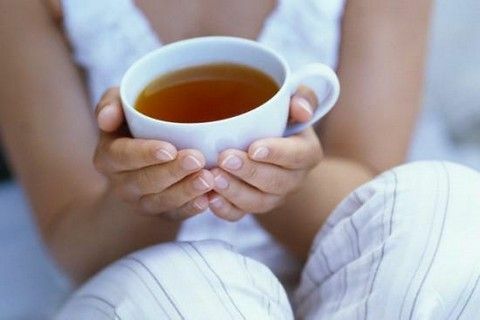Raspberry leaves are a powerful remedy. They are added to medicinal infusions, decoctions, and flavored tea. From this article you can learn all about the benefits and use of this part of the plant, and in the future this information will allow you to use the crimson leaf for the benefit of yourself and your relatives.
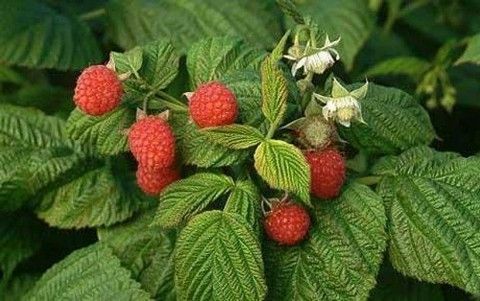
The healing power of crimson leaves
Raspberry leaves have a rich chemical composition, due to which they are capable of showing useful properties. These include:
- hemostatic;
- expectorant;
- is an anti-inflammatory;
- diaphoretic;
- is antipyretic;
- astringent;
- restorative;
- immunostimulating;
- is antitoxic.
Raspberry leaf is most often used to treat colds. Its broth will facilitate coughing, reduce body temperature and inflammatory process. This remedy is an excellent prevention of viral infections, especially during their exacerbation. This remedy can be used for angina and bronchitis, with a strong suffocating cough and other diseases of the respiratory tract. In addition, raspberry tea is often used to rinse the throat, as it perfectly removes puffiness and eliminates pain.

. And the benefits of raspberry leaves are not exhausted. This natural preparation shows high efficiency at bleeding - hemorrhoidal, gastric, and also at colitis and enterocolitis. Thanks to the antitoxic action of this raw material, slags and toxins are eliminated from the body. And astringent properties come to the aid at intestine disorders.
Weak immunity? Take for yourself the habit of drinking a glass of freshly raspberry tea a day and the result will amaze you.

Help the female body
What are the benefits of raspberry leaves for women? They are able to help with:
- inflammation of the appendages - in this case it is recommended to hold sedentary baths with the addition of decoction;
- diseases of the genital organs - here this drug is used for douching;
- profuse and painful menstruation;
- abnormalities of the ovaries, which caused infertility;
- during pregnancy, the broth helps to normalize the smooth muscle function of the uterus;
Important! Remember that the broth and infusion of crimson leaf pregnant can be consumed only after 36 weeks! And only after consulting a doctor!
- raspberry leaves are useful for building up the endometrium - for this they are brewed in the form of tea and taken three times a day for 100-120 ml.

Contraindications
However, raspberry leaves can not always display only useful properties, broths and infusions made from this raw material have some contraindications for use:
- individual intolerance;
- allergy;
- chronic constipation;
- nephritis;
- gout;
- parallel reception of aspirin.
Procurement of medicinal raw materials
Let's figure out how to dry the raspberry leaves so that they can give us their useful properties for a long time. Since fresh leaves contain a large amount of moisture, it is not allowed to dry them in cloudy weather. Otherwise, the raw materials simply rot. It is also impossible to carry out this process under direct sunlight, in which case a significant part of the useful substances will be destroyed.
Freshly picked raspberry leaves should be dried in fresh air under the canopies, spreading them with an even thin layer on the sacking cut. Also, it is allowed to dry in a well-ventilated area, for example, in an attic. To ensure that the harvested material is evenly dried, it must be regularly stirred and mixed.
Properly dried raw materials are as follows:
- leaves are evenly dry;
- have a slightly twisted form;
- color is green;
- rubs between fingers easily.
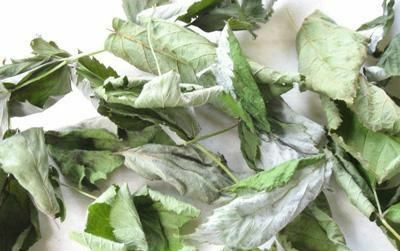
Fermentation
Fermentation of raspberry leaves is carried out in several ways.
- Take a few fresh leaves and roll them with a little effort between the palms - the leaves should become slightly darker. Such work should be done with all the raw materials that you are going to harvest. The resulting rolls must be cut into several parts.
- The second option is less time consuming. For its execution, crimson leaves should be folded into a large bowl and knead intensively, as if you are kneading dough. As a result, the juice will be released, and the leaf plates will become thin and slightly curl.
Recommendation! In the process of "kneading" do not forget to separate the formed lumps!
- The third way is the easiest. Leaflets must be passed through a meat grinder with a large grate, from time to time stopping the process so that the mass does not overheat.
Proper preparation of leaves for fermentation is considered to be their grinding by hand, that is, the first option. But if you like large-leaf tea, but method No. 2 suits you, and for fans of granulated tea leaves - method No. 3. Everyone has the right to choose the option that he likes best.
We send the workpiece to the fermentation: for methods 1 and 2, add the mass to the bowl and set it under pressure, with method 3 - simply shift it into a deep container and hold it with your hand.
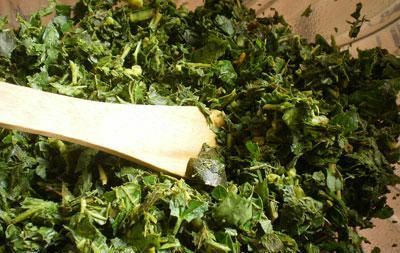
. From above, we cover the leaves with a cut of damp cotton cloth and send it to a warm place. Periodically, you should check if the fabric has dried out and, if necessary, moisten it. Fermentation should take place at a temperature of 22 to 26 ° C.If this mark is lowered, the fermentation will cease, if it is increased, then the main part of the components, which is responsible for the strength and aroma of tea, will die.
Recommendation! If the room where the fermentation takes place is cool, then the container with the mass should be wrapped in a blanket!
Finished mass should have a greenish-brown color and a strong floral-fruity odor. Further, the prepared leaves are laid out in a thin layer on a baking sheet and dried at a temperature of no more than 100 ° for about 2 hours in the oven. At the same time, the oven door must be slightly ajar. For uniform drying, the raw material should be stirred periodically.
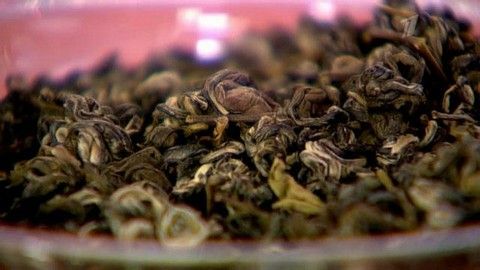
Fermentation can be:
- light - comes in 3-6 hours, the tea acquires a soft and delicate taste, but the aroma of it will be very strong;
- medium - comes after 10-16 hours, tea has a pronounced flavor and tart taste with pleasant sourness;
- deep - comes in 20-36 hours, tea turns tart with a light aroma.
Brewing tea
And lastly, how to brew raspberry leaves. To make tea, put a teaspoon of dried raw material in a cup and pour it with steep boiling water.
